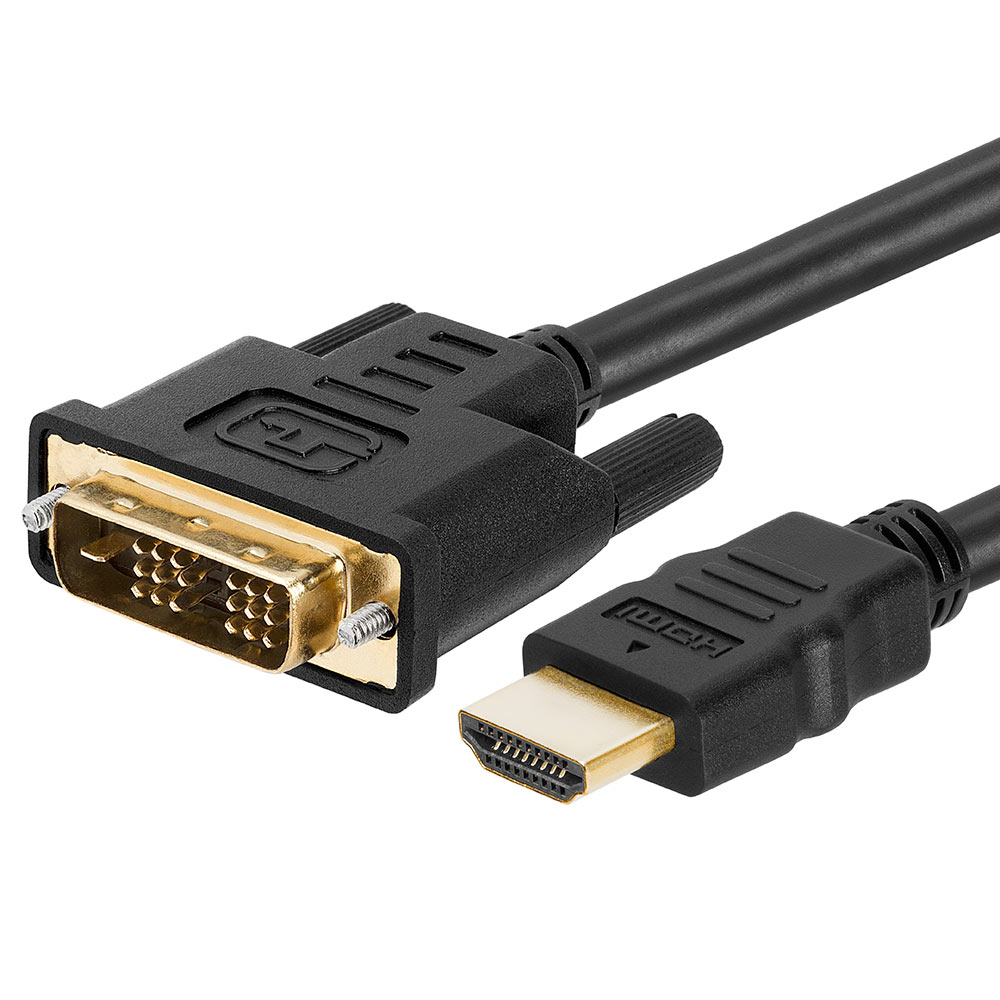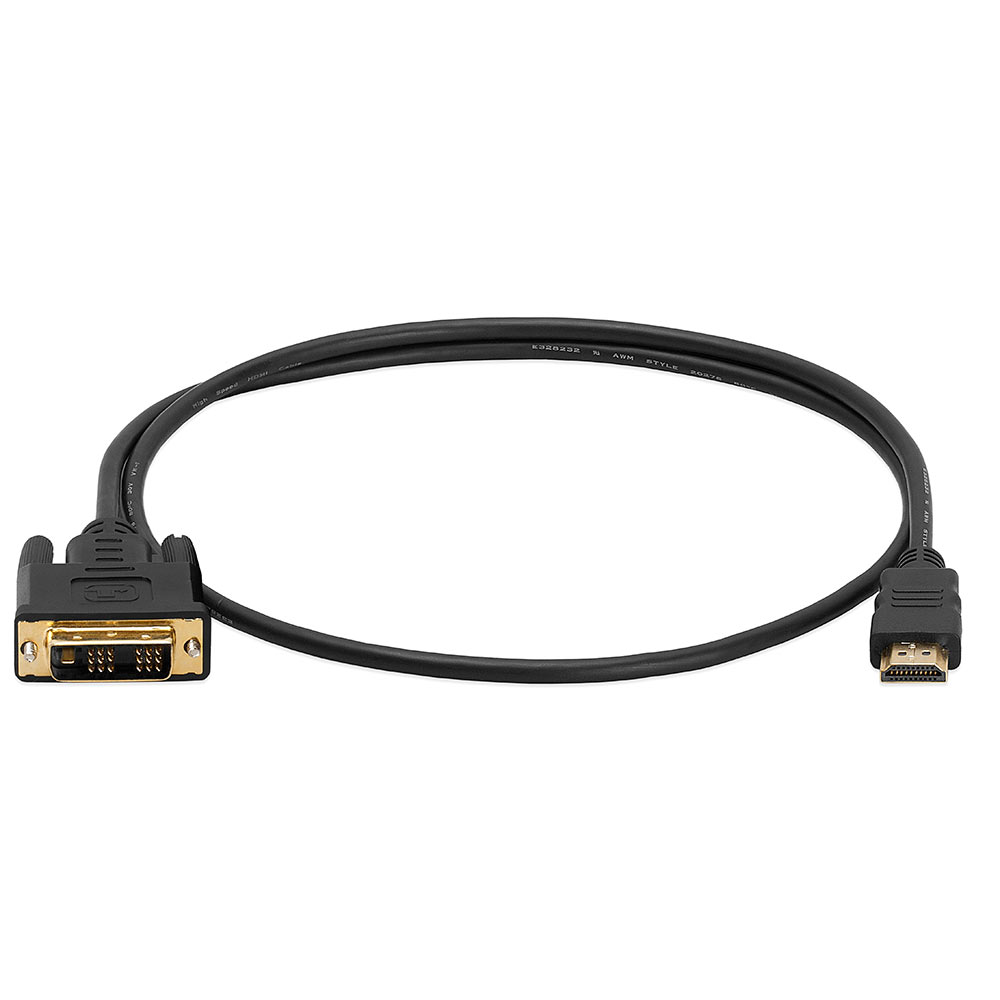HDMI To DVI Cables
In an ideal world, all video, audio and computer components would have the same types of connectors, and we could use the same cables to connect them in any way we’d like.
If you find that ideal world, please let us know immediately. In the meantime, we’ll all have to continue to deal with the hodgepodge of ports, connectors and cables usually required to carry data, audio and video signals from point A to point B with the least amount of interference and degradation.
The growing confluence of the video and computer worlds, perhaps best exhibited by the increasing dominance of Netflix, Amazon and Hulu, means that moving signals between video and computer systems has become commonplace. Unfortunately, most video and computer monitors use different standards for transmission and reception of high-definition signals: HDMI and DVI.
Some of the newest equipment on the market does actually support both DVI and HDMI. Most equipment, however, does not – so HDMI to DVI cables have become more important ingredients in your cable collection than ever.
The Difference Between HDMI and DVI
To understand why and when these cables are necessary, it’s first important to learn the difference between HDMI and DVI.
Actually, you can figure out the primary difference just by seeing what the two acronyms stand for. HDMI is short for High Definition Multimedia Interface. DVI is short for Digital Video Interface." One carries "multimedia" signals (meaning video and audio, and sometimes Internet signals as well) while the other carries only "video" signals. Obviously, that means a DVI cable isn’t going to be able to let you enjoy a movie from your Blu-ray player to your computer all by itself; it can only carry the video, while a separate cable will be required to transfer the audio track.
But there are still a number of important reasons you’d want to use an HDMI to DVI cable. We’ll explore them after we take a quick look at what HDMI and DVI actually do.
HDMI and DVI Explained
DVI was first introduced in 1999, as a way of transferring the digital video signals which were becoming common using the high-def technology which was emerging at the time. Neither were supported by the analog VGA connectors and cables that had been standard for more than a decade. DVI was used for a while on first-generation flat-screen HDTVs and monitors until the development of HDMI; for reasons you now understand, a connection which carried both audio and video (HDMI) was vastly more desirable than one which can only transfer video (DVI). However, DVI remained the most-common choice for high-speed video connections between computers and their monitors, and is only today starting to be replaced by technologies like DisplayPort.
Most of the major manufacturers of consumer electronic equipment combined their efforts to develop HDMI in the early 2000s, with the aim of creating a universal interface which could transfer uncompressed video and digital audio signals between devices – and a secondary aim of being compatible with DVI. It began rolling out on consumer products a short time later and is still the standard today, although there have been several new versions released over the years to boost capacity and performance, and build in new functions. HDMI is able to transfer today’s state-of-the-art 4K high-definition signals and surround sound audio without loss or degradation.
What’s most important for our purposes is that DVI and HDMI each use the same method to move video signals from one component to another: TDMS, which stands for "transmission minimized differential signaling." In a nutshell, two versions of the digital signals are encoded at their origination point to make sure they aren’t degraded, and are then decoded when they reach their destination. The TDMS system compares the two signals to make sure they’re the same and makes any necessary adjustments, and then delivers the final video to the monitor or device.
The reason that’s important is that it means DVI and HDMI signals are compatible; you don’t need any other encoders, decoders or converters. All you need to connect between a DVI port and an HDMI port is a cable with the right connectors on each end.
Why would you want to do that? Read on.
Uses for HDMI to DVI Cables
Not too long ago, your home entertainment system was in one room, your computer was in a different room, your laptop was packed up and ready to go with you to work or on a trip, and your phone was in your pocket. Today, all are likely to co-exist in the same space, and perform many of the same functions – sometimes simultaneously.
Want to curl up on the couch or in bed with your laptop in order to watch that new Blu-ray movie you just picked up, or watch the movie on your desktop computer while you work? Just plug one end of the cable into the HDMI output in your home theater, the other end into the DVI port on your computer, and hook up an audio cable. You have video on your computer that you want to show the crowd in your living room? An HDMI to DVI cable can send video to your wide-screen HD monitor just as easily. If you receive streaming internet video from sources like Netflix on your computer, this cable will let you feed it to your TV. Connections between video game systems and DVI-equipped monitors become simple with one of these cables, and there are many video projector systems which will also require HDMI to DVI connections. In short, modern video equipment and computers which never needed to "talk" to each before other can converse with ease with an HDMI to DVI cable.
How to Shop For an HDMI to DVI Cable
Here’s the good news: choosing an HDMI to DVI cable is really simple. You don’t need those high-priced cables that promise performance good enough for NASA or the defense department, because any cable that meets HDMI and DVI standards and comes from a reputable manufacturer will do the job just fine.
Just make sure that you know what you need. There are mini- and micro-HDMI connectors that are used on cameras and hand-held devices which are different than the standard HDMI connectors on home theater and video equipment, and there are old-school HDMI 1.0 connectors which you’ll only find on very old equipment. There’s also something called DVI-A which is an analog format, not a digital one. As long as you’re connecting fairly new components and connectors, a cable with HDMI 2.0 on one end and DVI (sometimes called DVI-D) on the other is all you’ll need.
One more concern to be aware of: distance. If the computer and video equipment are more than 15 feet away you won’t be able to transmit signals in full HD resolution, and you may need a signal amplifier if the distance is greater than 50 feet.
Cmple has a wide assortment of these HDMI to DVI cables, exceeding all standards and manufactured to our demanding requirements, and gold-plated to fight corrosion.





